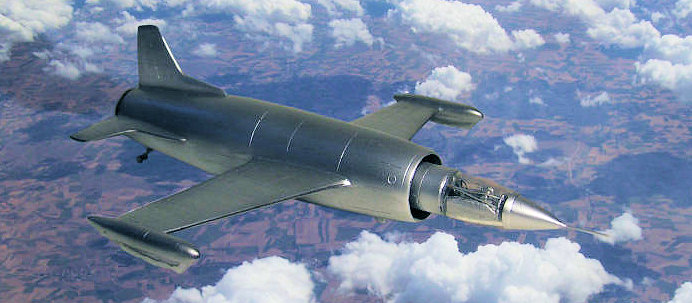
Mach 2 1/72 Leduc 021
| KIT #: | 0010 |
| PRICE: | €22.00 |
| DECALS: | One option |
| REVIEWER: | Martin Pohl |
| NOTES: | ...lots of fun with short run |

| HISTORY |
When searching about the history of the
ramjet, you can find four names: Charles De Louvrier, René Lorin, René Leduc and
Paul Schmitt. Louvrier (France) was the first to present such a device at the
end of the 19th century. In 1913 one could read an article in the “Aerophile”,
a French technical review, published by Mr. Lorin. Lorin (France) was not able
to realize his idea. About twenty years later Leduc (France) re-invented the
ramjet again. He requested a patent in 1930 for his device three month earlier
than Paul Schmitt, a German , who also was working on that kind of engine, which
today is know under the name “pulse-jet”. So Renè Louvrier is to be named as the
first one to come up with this idea. Leduc wanted to overcome the limitations of
the pulse jet and found a system in which only the streamline flow makes it
possible to obtain the necessary compression. He was able to presented in 1936
an aero thermodynamic duct of 30 mm in diameter. So René Leduc was the first to
make it work. In 1937 the 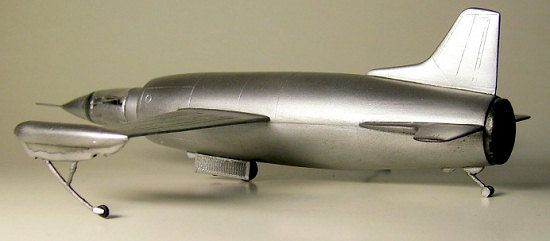 Leduc 010 project was initialized with the official
number 407/7. Leduc these days was employed by Louis Breguet at the factory in
Villacoublay. Because of the war the project was delayed for about 10 years
until 1946. In this year, exactly on November 19th the composite
flight, the Leduc 010 mounted atop the Languedoc, took place.
Leduc 010 project was initialized with the official
number 407/7. Leduc these days was employed by Louis Breguet at the factory in
Villacoublay. Because of the war the project was delayed for about 10 years
until 1946. In this year, exactly on November 19th the composite
flight, the Leduc 010 mounted atop the Languedoc, took place.
The main problem of a ramjet engine is the complete absence of thrust, when the plane is sitting on the ground. So Leduc mounted his bird on top of an especially modified SE-161 Languedoc a four engine transporter. This combination strongly reminds on the German Mistel projects. The Leduc 010 made his first free gliding flight on October 21st in 1947. Also the first landing after this free gliding was a bit of a mess, because the plane overshot the runway and the tires blew out, the plane performed better than expected and program was continued.
During the war, various tests had been conducted (particularly in the USSR and in Germany, but also in the United States) on ramjet engines installed experimentally on transporter airplanes. This type of propulsion was even used on some gun shells to increase their range, and many other projects were born as well. However, the flight of the Leduc 010 on April 21st 1949 with its ramjet operating represents the first flight of an aircraft solely propelled by a ramjet engine. The Leduc 010 performed extraordinary; it reached 11.000 meters in just a few minutes and was the first French plane to find the effects of compressibility when reaching the speed of Mach 0.85.
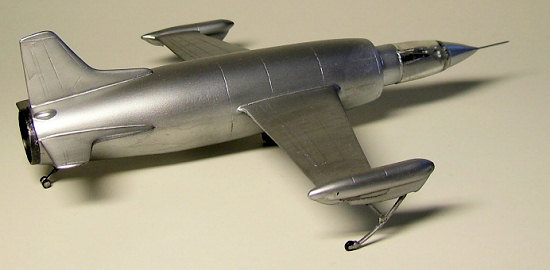 The first 010 was flown by Jean Gonord
and the second one, build in 1951, by Yvan Littolff. Around this time a third
prototype was build up with two additional mounted engines at the wingtips, the
Leduc 016. Unfortunately the 016 performed not very well together with the
wingtips mounted engines so those were removed.
The first 010 was flown by Jean Gonord
and the second one, build in 1951, by Yvan Littolff. Around this time a third
prototype was build up with two additional mounted engines at the wingtips, the
Leduc 016. Unfortunately the 016 performed not very well together with the
wingtips mounted engines so those were removed.
The first 010 was lost during a trial run by CEV (French flight test center) because of a technical failure. Round about a year later the second 010 was lost. The flight tests were continued with the 016 until the bigger 021 was ready for testing in 1952. Two of the 021 were built and together they made 385 flights including 248 releases in free air. The 021 was presented at Le Bourget air show in 1955. The two 021 completed their career when the Leduc 022 accomplished its first flights, in December of 1956. It was equipped with a centrally mounted turbojet, which enabled it to take off and fly on its own power, without the assistance of a transporter airplane. It totaled 141 flights during the following year, until a taxiing incident caused damages to the fuselage. The program was cancelled in 1958 and René Leduc was pressed to give up his work as an aircraft manufacturer. But even this company is not building airplanes anymore it still exists in France and is now located in Azerailles, in the Meurthe-et-Moselle region (east of France) where hydraulic components are built.
010/016 and 022 can be seen at Le Bourget Museum Paris
| THE KIT |
What to say about a Mach2 Kit or especially the Leduc 021 – well Mach2 are short run injection molded plastic kits with normally acceptable sink and ejector pin marks and some flash around the parts. I’ve seen some of them and all were in a state one would accept for those kinds of kits. Only this boxing of the Leduc was a little outstanding here, because it has sink marks all over and out of the flash you could build a second model. My example was also different to the review example ( http://modelingmadness.com/scott/korean/leduc021preview.htm ), it had a one piece canopy, more on this later.
The panel lines were very fine and raised. Some of the parts were not complete, which means that the pressure or temperature when filling the mold was eventually not high enough, so the parts were missing plastic in the middle.
| CONSTRUCTION |
So, as written above, the construction of
my Leduc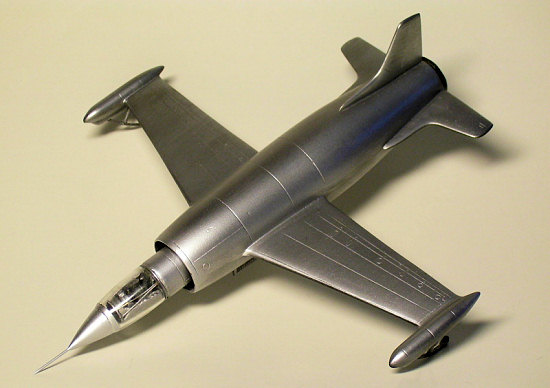 started with some
hours of cleaning the flash, cutting away the injector pin marks and sanding the
damn thing into shape to get the parts somehow to accept their neighbor.
started with some
hours of cleaning the flash, cutting away the injector pin marks and sanding the
damn thing into shape to get the parts somehow to accept their neighbor.
The really big shock came when looking at this piece which should be the canopy (it was my first guess and I was right!). I’m sorry, I don’t have a picture of it when it came out of the box. It looked like a nearly clear cap of a pencil or whatever, closed on one side and all the flash was inside. I tried to redo it with a self made piece, but this doesn’t work. So after three attempts to form a new canopy my nearly clear cap of a pencil canopy wasn’t clear at all. It now looked like an almost white cap of a pencil canopy. But this was my fault – anyway – after open it from the front to remove all the flash, sanding and polishing it from inside and outside for hours, dipping it into Future for 4 or 5 times, it almost looked like a clear canopy. After all the canopy is missing this bobble on top of it, the mirror I guess. This piece was given in – well – some kind of clear plastic. I decided not to use it and leave the canopy as it is now.
After this odyssey with the canopy and all the sink marks on the body preparing the wings of the bird were just like spending holidays in Spain. Of course after filling and sanding those areas, I lost some of the panel lines, so I rescribed them a little.
All the pieces went together only with some extra fixing. As stated above, after – did I mention already – a lot of filling and sanding, the Leduc started to look like it should.
Only the cockpit inside this almost clear cap of a pencil canopy was a bit of a problem, because of the parts which were not completely molded. These parts have to be replaced bits and pieces.
| COLORS & MARKINGS |
The cockpit area was painted with some shades of silver/grey and some weathering.
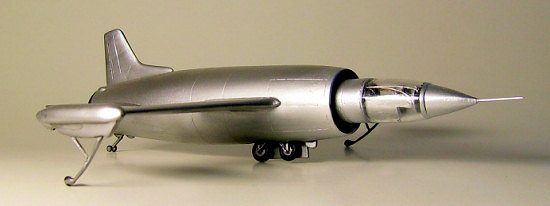 For painting the outside after all this
treatment with sandpaper, I first brushed two layers of base. As this bird is
natural metal I used Createx Auto Air black base. It’s just me, I guess, using
this stuff. It’s thick enough to fill the rest of some sanding seams and it is
thin enough to spray it out of the bottle with a medium nozzle; and of cause it
does not smell as it is acrylic. The Base was polished with a sanding mate which
is around 1000 grid. On top of this went Alclad II Aluminium. I did not polish
it because when studding the rare pictures of the real thing it does not look
that shiny.
For painting the outside after all this
treatment with sandpaper, I first brushed two layers of base. As this bird is
natural metal I used Createx Auto Air black base. It’s just me, I guess, using
this stuff. It’s thick enough to fill the rest of some sanding seams and it is
thin enough to spray it out of the bottle with a medium nozzle; and of cause it
does not smell as it is acrylic. The Base was polished with a sanding mate which
is around 1000 grid. On top of this went Alclad II Aluminium. I did not polish
it because when studding the rare pictures of the real thing it does not look
that shiny.
Some weathering was done with my typical soup, a mixture of some brown, black, red and other airbrush colors thinned by around 60% with soapy water. The main reason for me using this is because you can remove it with water at any time.
I decided not to use the decals, because if you look at the references (see links at the end), you will find the 021 with and without any markings.
| CONCLUSIONS |
I even can see you all shaking your heads and thinking “ why does this crazy guy spent all of this time in building such a .. THING” – well ….
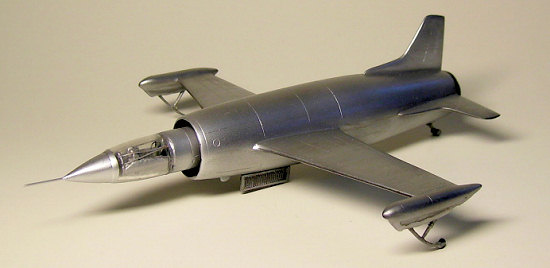 1.
I love those strange kind of birds and you only get this from Mach2 as
far as I know,
1.
I love those strange kind of birds and you only get this from Mach2 as
far as I know,
2. after all, it was fun to build,
3. For me it is faster to build the Mach2 kit than building it completely from scratch (assuming that I’m able to scratch build which I don’t believe) and
4. it is funny to see people looking at it and wondering what this “THING” probably could be. Most of them are guessing its some SF may be Flash Gordon or something.
Ok it took a lot more time to get this done, but after all I really like it. So, if you ask me, I would recommend this kit to everybody who likes strange kind of airplanes and who has done some kits in the past, because you need to know how to handle all those surprises. In the end you will have an airplane which one can’t see that often. The only thing I would recommend; if you have the chance to look into the box before buying it, do it, as Mach2 kits could differ a lot.
Comparing it to the resources; for me the end result does look like a Leduc 021.
The Mach2 Leduc 022 will follow some day, its already waiting here.
| REFERENCES |
Wikipedia: http://en.wikipedia.org/wiki/Leduc_experimental_aircraft
AirBorneGrafix.COM: http://www.airbornegrafix.com/HistoricAircraft/ThingsWings/Leduc.htm
Aerostories: http://aerostories.free.fr/constructeurs/leduc/page6.html
October 2007
Copyright ModelingMadness.com. All rights reserved. No reproduction in part or in whole without express permission from the editor.
If you would like your product reviewed fairly and fairly quickly , please contact the editor or see other details in the Note to Contributors.